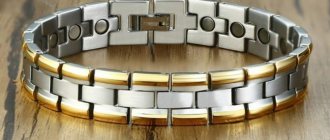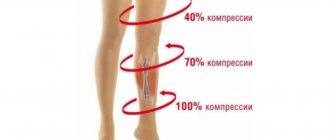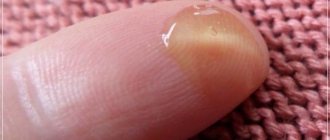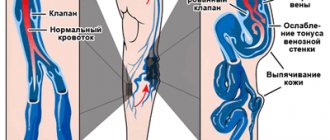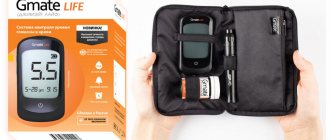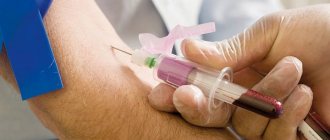Veins are half of the circulatory system.
It is also a source of concern for millions of people around the world.
Vein diseases are widespread. Scientists estimate that up to 15% of middle-aged men and 30% of middle-aged women suffer from varicose veins - dilation of the vessels of the venous system. Among the elderly, the proportion of patients with venous diseases is even higher.
Therefore, many people turn to doctors to treat swollen blood vessels. Sometimes with the help of surgery. In other cases - conservative therapy consisting of medications, exercises and special underwear.
We'll talk about stockings for varicose veins later. In the meantime, let’s evaluate the danger of the disease and its possible complications.
Varicose veins can affect any part of the venous system, but its favorite target is the vessels of the legs.
The vulnerability of veins is explained simply.
When blood flows through the arteries to the organs, it mainly moves downwards. That is, the force of attraction helps blood flow and therefore blood does not usually accumulate in the arteries. It flows through the arteries to the feet. The blood rises back through the veins. At this moment, problems begin - the force of gravity slows down the blood flow, and some of the blood constantly strives to flow down.
The situation is not dire. Yes, blood circulation in the veins is difficult, but the body has protective mechanisms against such trouble.
Venous valves grow inside the vessels, which close the passage of flowing blood and return it to the bloodstream. Muscles also help blood move. They contract and put pressure on the veins, and as a result, blood circulation improves.
In diseased vessels, blood flow is impaired. This happens for various reasons:
- Long immobility
- Obesity
- Elderly age
- Pregnancy
- Hormonal imbalance
In varicose veins, the valves are usually weakened or damaged. Therefore, blood accumulates in certain areas of the vessels, puts pressure on the venous walls and causes expansion.
The symptoms are not the most severe at first:
- Feeling of heaviness in the legs
- Blue or purple blood vessels appear on the skin
- Convulsions
- Edema
- Change in skin color
- Itching and burning in the veins
Such signs of illness often go unnoticed, and sometimes people simply get used to them. Thus, they allow varicose veins to develop.
Yes, it may take more than one year for more severe symptoms to appear. But without treatment, complications are inevitable, and they are not at all as harmless as the first manifestations of varicose veins.
Consequences of advanced varicose veins:
- Trophic ulcers
Non-healing wounds near diseased vessels. The tissues do not receive the necessary nutrients and gradually die. A symptom of an ulcer is the area of skin turning white. To stop the development of complications, you need to consult a doctor as soon as possible.
- Bleeding
Enlarged superficial veins sometimes burst. Bleeding from such vessels is not very severe, but medical attention is still necessary.
- Blood clots
Dilated vessels are a comfortable environment for blood clots, which doctors call thrombi. These formations interfere with blood circulation. They also sometimes come off and can get into the lungs with blood. This phenomenon is called pulmonary embolism and it often leads to breathing problems and even death.
The further the disease progresses, the higher the risk of complications. Another problem is that developed varicose veins usually cannot be eliminated with conservative treatment and surgery is required.
It is much easier to deal with it at an early stage. Complex treatment using stockings against varicose veins shows excellent results. This underwear is also useful for preventing illness.
What are compression stockings for?
This knitwear improves blood circulation in the legs. As a result, pain and swelling that bother many people are reduced. Underwear also helps against more serious diseases, for example, they reduce the risk of deep vein thrombosis and the likelihood of blood clots.
Elastic stockings for varicose veins are made of a special material that stretches well and fits the leg. Knitwear gently compresses the veins. Typically, underwear puts the most pressure on the ankles, with less pressure up the leg.
Doctors prescribe compression stockings for different purposes:
- Vein support
- Prevention of blood accumulation
- Prevention of trophic ulcers
- Combating venous hypertension
- Improved lymphatic drainage
When knitwear puts pressure on blood vessels, it has several positive effects:
- Reduces vein diameter
Blood flows faster through narrow vessels. Therefore, it extremely rarely accumulates in one place and blood clots almost never occur.
- Improves blood flow
Thanks to the additional pressure, the blood moves faster and travels faster from the feet to the heart.
- Prevents blood from draining
Despite the force of gravity, blood rarely flows down the veins and does not fill the connecting vessels.
Even some athletes use compression stockings in their training. For example, runners and basketball players. Underwear protects tissues from damage and accelerates the delivery of oxygen to muscles. After training, muscles recover faster.
Of course, compression stockings for varicose veins cannot be considered a magical artifact that will save you from any problems with blood vessels. Unfortunately, it is not. Like other medical products, compression stockings are not suitable for everyone.
A little history
The founders of scientific medicine described in their works methods for healing trophic ulcers using various bandages and pressure bandages. That is, compression therapy has been around for many years. The history of industrial production of knitwear with compression properties began back in the distant 29th year of the last century in eastern Thuringia. At that time, Thurangia was the only place where medicinal knitwear was produced. Today, various products made from this material can be purchased in any city in the world. Naturally, compression underwear in general and compression stockings in particular are not a panacea for all problems, but such “clothing” significantly improves health, provides freedom of movement, reduces pain, and also promotes speedy recovery in the postoperative period. Compression stockings make the patient’s life more comfortable, so you shouldn’t ignore the advice of doctors, you need to try everything that can help cope with varicose veins!
Indications and contraindications for wearing compression garments
Do not buy shaper stockings yourself. First, go to the doctor and check what kind of jersey you need.
Find out the size. Compression ratio. And other characteristics of underwear that you will wear for months.
Buying knitwear without a doctor's recommendation can harm blood vessels. For example, stockings put too much pressure, and as a result, blood circulation in the veins will be disrupted even more. The result is that the condition of the blood vessels worsens.
Make an appointment with a phlebologist about choosing compression garments. Also, read the indications and contraindications for such stockings.
Indications
Doctors prescribe shapewear for the following diseases:
- Chronic venous insufficiency
- Phlebeurysm
- Deep vein thrombosis
- Lymphedema
- Phlebitis
- Lipodermatosclerosis
Also, knitwear is sometimes prescribed to healthy people who are at risk for vascular diseases. The need for stockings arises:
- During pregnancy
The body of the expectant mother is subjected to great stress. Hormonal balance is disrupted. This causes the venous walls to weaken and often expand. The amount of blood in the body also increases. Because of the child. The increased volume of blood greatly increases the load on the walls of blood vessels. Knitwear helps the veins maintain their normal shape under such high pressure.
- Due to increased stress on the legs
At work, many people have to stand on their feet for a long time and therefore the pressure on the vessels of the lower extremities increases. Frequent exercise can cause varicose veins. The underwear supports the veins. So they remain healthy even in people who spend the entire working day on their feet.
- With a sedentary lifestyle
The less a person moves, the more difficult it is for veins to pump blood. The muscles do not work and do not improve blood circulation, so the blood often accumulates and dilates the blood vessels. Knitwear stops the swelling of veins.
- After vascular surgery
The success of surgical treatment largely depends on the correct recovery of the patient. When the procedure is completed, the doctor prescribes knitwear. It must be worn strictly on schedule, since any violation of the regimen can lead to a relapse of the disease.
The correct choice of elastic underwear is very important. Phlebologists prescribe knitwear of a certain degree of compression and class, depending on the patient’s disease and risk factors.
Contraindications
For most people, compression stockings are completely safe. They have only a few restrictions:
- Suspicion of peripheral arterial disease or already diagnosed
- Severe peripheral neuropathy
- Extensive swelling of the legs or pulmonary edema after heart failure
- Allergy to knitwear material
- Skin and soft tissue problems: gangrene, dermatitis, severe cellulite
Some patients simply cannot wear elastic undergarments effectively.
Sometimes only temporarily. For example, they have wounds on their leg and need to wait for them to heal.
In other cases - constantly. For legs of an unusual shape or with deformation, compression hosiery is not suitable. It simply does not grip the limbs properly and therefore will be useless against vein disease.
Where did compression stockings come from?
Even the builders of the ancient Egyptian pyramids knew that excessive stress on the lower limbs, hard work and prolonged standing on the feet provoke heaviness, swelling and varicose veins .
It is for this reason that the Egyptians wrapped their limbs with tight bandages. Over time, the military began to use this invention. In the Russian army, military personnel wore “onuchi” - special compression bandages that helped withstand long distances on foot.
The ancestor of modern knitted compression garments was an elastic bandage, which is made from special elastic fibers. Initially, it was intended for tightening wounds, and later, its compression properties became a separate method of therapy. Since the middle of the last century, special products for medical use with a compression effect have been appearing.
To this day, they are actively used for the prevention and treatment of varicose veins, edema, and restless legs syndrome. Therapeutic knitwear is produced using certain technologies that differ from the production of ordinary tights and stockings. It has different degrees of compression along the entire length of the product, which ordinary stockings do not have. For the manufacture of compression garments, special fibers and materials are used to ensure comfort and safety of use.
How to choose compression stockings
Elastic knitwear against varicose veins includes models of different lengths. Some cover their entire legs. Others - only to the knee. It depends on the purpose of the compression stockings.
An important characteristic of underwear is pressure, which directly affects the effectiveness of knitwear. Stockings should fit tightly to your legs, but not cause pain.
Some models are designed specifically for operated patients. They are not suitable for other people.
The degree of compression of knitted stockings for the treatment of varicose veins will be determined by the doctor. Therefore, be sure to sign up for an examination and buy elastic underwear only after consultation.
Check the knitwear in the store. Choose products:
- Antimicrobial and hypoallergenic
- No seams
- With a service life of 12 months
- With RAL quality standard
With proper care, such underwear will last a long time and you will not have to change it until the end of the course of treatment.
Types of Compression Stockings
All models of slimming knitwear are divided into three types:
- Preventive
These products are not considered medical and therefore can be purchased even without a doctor's prescription. They simply support the blood vessels. This type of underwear reduces fatigue and pain in the legs. Knitwear puts little pressure on the veins and is great for preventing vascular diseases, but does not treat varicose veins.
- Medicinal
The most extensive group of elastic stockings. For these products, the level of pressure in different areas is different - near the ankle, the underwear compresses the most, and up the leg the pressure weakens. Therapeutic knitwear is prescribed by a doctor. Stockings are intended for people with varicose veins and thrombophlebitis.
- Anti-embolic or hospital
This underwear is prescribed to people who must remain in bed after surgery. It helps reduce the risk of deep vein thrombosis. High compression class. The pressure in different areas of the stockings varies, just like with medical products.
Yes, you can buy elastic underwear yourself to prevent vascular diseases. But we still advise you to consult a doctor. He will help you choose knitwear. The phlebologist will also tell you about other preventive methods, so you will learn to protect your veins much better.
Compression levels of compression stockings
According to the pressure level, elastic underwear is divided into four classes:
- Compression up to 22 mm Hg. Art. This knitwear helps stop the development of varicose veins - it removes swelling, spider veins and other signs of varicose veins.
- Pressure up to 32 mm Hg. Art. Second class stockings are prescribed to patients with chronic venous insufficiency, thrombophlebitis and varicose veins. Knitwear is also used for prevention by people with a sedentary lifestyle.
- Compression up to 46 mm Hg. Art. These stockings are worn by patients with trophic disorders and congenital defects of the vascular system.
- Pressure up to 50 mm Hg. Art. Doctors prescribe such knitwear only to people with severe forms of venous disease. Lingerie is used in the treatment of severe edema.
The correctly selected level of compression allows you to successfully combat vascular diseases, while unsuitable knitwear further harms the veins.
Choosing the right size of underwear is equally important.
Compression stockings size chart
Before purchasing underwear, be sure to take your feet measurements. Need to measure:
- Calf circumference
- Ankle circumference
- Thigh circumference
- Leg length from floor to hip
- Foot length
Take all measurements in the morning, after waking up. Do not get out of bed - this way you will achieve the most accurate results, which cannot be obtained in a standing position due to the pressure on the blood vessels. Recording your leg measurements will be useful when using the stocking size chart.
| Size | Height, cm | Weight, kg | Hip volume, cm |
| S; S1 | 150 – 162 | 41 – 55 | 90 – 100; 90 |
| M; M1 | 152 – 170 | 55 – 75 | 88 – 100; 98 – 115 |
| L; L1 | 155 – 175 | 58 – 95 | 113 – 130; 98 – 115 |
| XL | 167 – 180 | 68 – 95 | |
| XXL | 160 – 178 | 85 – 108 |
Size
Therapeutic knitwear must be chosen correctly, otherwise it will not work. Tights that are too large will not be able to work on the veins. And too tight tights can even cause harm and compress blood vessels.
Put on compression hosiery after a night's rest without getting up - at this time there is no swelling or it is minimal. Therefore, it is necessary to measure the circumference of the lower leg and thigh to select the appropriate size of the product at this time. A store consultant can help with accurate measurements. There is an article on our blog for more details on sizing.
If you do not put on knitwear immediately after waking up, for example, in the middle of the day or after taking a shower, you need to lie down for 10-15 minutes with your legs up and then just put it on.
How to put on and wear compression stockings correctly
First of all, put on elastic underwear immediately when you get up. Without even getting out of bed.
Raise your leg. It should be above the level of the heart - in this position the pressure in the vessels decreases. Carefully slide your foot inside and slowly pull the fabric up.
Smooth out your stockings. They should fit snugly to the skin. Smooth out the folds. The top of the underwear should not be folded down, otherwise the knitwear will press like a tourniquet, and as a result, blood circulation will be impaired.
It is not recommended to remove compression stockings during the day. Only in the shower or bath. Before going to bed, lie on your bed and elevate your legs. Then take off your underwear.
How long should knitwear be worn?
Ask your doctor. Mild forms of varicose veins can be eliminated in a few months, but chronic diseases are a more serious problem. Sometimes phlebologists recommend that patients wear elastic stockings for several years. In rare cases - all your life.
If treated carelessly, knitwear will not last even a few months. Therefore, it is necessary to properly care for it.
Basic mechanisms of action of elastic compression.
- Due to the compression of soft tissues, additional support is created for diseased veins, preventing their further expansion.
- The diameter of the superficial veins decreases, the speed of blood flow accelerates, significantly reducing the risk of thrombosis.
- By increasing tissue pressure, the development of edema is prevented
- Under the influence of compression, the diameter of the vessels decreases - the valve flaps come closer together, the flow of venous blood is normalized (from bottom to top).
Caring for compression stockings
The stockings do not look like a durable product. And indeed, usually their service life does not exceed 12 months, and in many cases the linen breaks and becomes unusable even earlier.
What to do?
First of all, stockings need to be washed. Including knitwear with antimicrobial protection. Remember - you wear elastic underwear all day and dead skin cells constantly accumulate on it. So wash it daily.
It's best to do it manually.
For washing, use baby soap or other delicate products that will not damage the knitwear. You cannot boil laundry.
After washing, squeeze the water out of the stockings very carefully. Do not stretch them, otherwise you will damage the fabric. You can remove moisture with a towel.
Dry knitwear on a flat surface only in cool or warm places, as extreme heat can destroy the material.
Even with proper care, stockings will sooner or later lose their elasticity. Sometimes after just a few months. Less often - after a year.
How to change knitwear in time?
The loss of elasticity is easy to notice in the morning when you put on stockings. Old compression garments stretch very easily. Hence the conclusion - it no longer grips the legs with the required strength and therefore it is necessary to buy a replacement.
What is the therapeutic effect based on?
The principle of the therapeutic effect of stockings made of compression material is based on creating pressure of varying strength on certain areas of the lower extremities. In this case, the maximum compression force is applied to the part of the leg in the supramalleolar region. This nuance is due to the fact that the greatest effort is required for the blood to flow upward from the lower part of the leg. As the blood flows upward, the load on the veins gradually becomes less. The upper part of the shin takes on 70% of the pressure inherent in the stocking, and the thigh accounts for only 40%. The principle of compression stockings is that the material fits tightly around the leg, thereby squeezing the veins and helping to push out stagnant blood, improving blood flow.
Due to this even distribution of the load, the blood flow, which invariably goes to the heart, returns to normal. The type of compression built into the stocking is similar to the load that is created by the work of muscles during natural human movements. People who use compression stockings claim that at the end of the day their legs are much less tired than before using the stockings, and swelling is almost completely absent.
Doctors say that systematically wearing therapeutic stockings:
- Provides protection of veins from expansion.
- Helps normalize blood flow in the lower extremities, which significantly improves the supply of oxygen and essential nutrients to all tissues of the body.
- It is an effective measure for the prevention of thrombosis.
- Exerts stable and correct pressure on the surface of the legs.
How long to wear compression stockings after surgery
Elastic knitwear is not only included in the complex treatment of vascular diseases and is used to prevent varicose veins. This type of underwear is also prescribed to patients who have undergone surgery. Sometimes for several days. In other cases for months.
The duration of wearing stockings is determined by the doctor.
After treatment, the knitwear must be used for different times, depending on the procedure:
- Caesarean section - up to three weeks
- Hysterectomy – two to eight weeks
- Laparoscopy – from three days to a month
- Kidney removal - from five days to four weeks
- Removal of the gallbladder - from ten days to a month
How long to wear compression stockings after sclerotherapy?
It is necessary to take into account the number of vessels that the doctor treated. During the operation, the phlebologist uses different methods to destroy the inner walls of the veins, causing them to become inflamed. Blood circulation in the vessel stops, and after some time the diseased vein completely disappears. Blood moves through other vessels.
In this case, compression stockings help keep the treated veins closed and prevent blood from entering them. Therefore, the vessels disappear faster.
Elastic underwear should be worn for up to four months if the doctor has operated on one or two veins. A larger number of removed vessels must be maintained longer—six months. Moreover, this is not a full term. The patient wears second-class knitwear for so long, and then the doctor can replace it with first-class underwear.
Constriction stockings are also used in other vein surgeries. For example, they are useful for recovery from phlebectomy and miniphlebectomy.
But endovasal treatment does not require compression therapy, and underwear is used only if signs of venous insufficiency persist - edema and trophic disorders.
Unfortunately, this information is not universal. It cannot be applied to absolutely every situation and every person. The doctor prescribes hosiery and determines how long patients should wear special stockings.
Reading about elastic underwear is a good start, but the real fight against vascular disease will only begin after a visit to the doctor.
How to choose the right product
The type of compression garments is selected by a specialist on a strictly individual basis, taking into account certain nuances of the condition of the venous system. For example, compression socks may be suitable for some patients, but they often negatively affect the veins located in the area under the knee, so most often phlebologists prescribe their patients to wear stockings made of compression material. Stockings can be of different lengths: up to half the thigh or even higher, up to the groin area. Today, all models of compression stockings have a fixing elastic band made of silicone, so if a person is allergic to silicone, it makes sense to use compression tights rather than stockings.
Recommendations for selection
The criteria for selecting compression tights are the following factors:
- strict adherence to the phlebologist’s recommendations regarding the selection of underwear according to the degree of compression;
- mandatory compliance of the product with the European RAL standard, the presence of which sign guarantees the necessary qualities in terms of material composition, compression properties, strength and elasticity of knitwear, etc.;
- the presence of characteristic markings indicating not the density (as is the case with conventional hosiery), but the pressure level in mmHg;
- price from 1500 rubles, which serves as confirmation of the quality of the product;
- the appropriate size of compression garments - stockings or tights.
